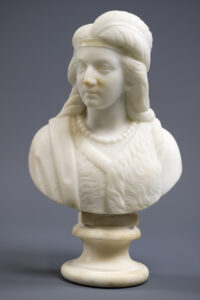The Georgia Museum of Art recently received a grant for $75,000 from the Terra Foundation for American Art to support the planning process for the exhibition “The Sculpture of Edmonia Lewis.”

Edmonia Lewis (American, ca. 1844-1907), “Minnehaha,” 1868. (Georgia Museum of Art, University of Georgia)
The exhibition, which will tour nationally, focuses on the works of 19th-century neoclassical sculptor Mary Edmonia Lewis. A talented young sculptor who traveled to Rome in 1866, Lewis broke international, racial and gender barriers. Her status as a successful woman artist along with her African and Indigenous (Mississauga) identity complicated the critical reception and promotion of her work during her life. Following her death, Lewis’ contribution to American sculpture was largely underrecognized. Scholars have only recently begun to redress this omission. This exhibition and an accompanying publication will further remedy these oversights and recenter the artistic advancements and defiant social commentaries of Lewis and other historical female artists and artists of color.
Organized by Shawnya L. Harris, the museum’s deputy director of curatorial and academic affairs and Larry D. and Brenda A. Thompson Curator of African American and African Diasporic Art, and Jeffrey Richmond-Moll, the museum’s former curator of American art and currently George Putnam Curator of American Art at the Peabody Essex Museum, the exhibition will highlight the sculptor’s transatlantic career by presenting 25 to 30 unique sculptures produced from the 1860s to the 1890s that represent the vast majority of extant works by the artist.
Lewis’ subjects include abolitionist and political leaders, Indigenous themes and classical, religious and mythological figures. The exhibition will place her sculptures into conversation with visual commentaries on enslavement and abolition by artists of color like Robert S. Duncanson and considers the popularity of mythology and sentimentality within abolitionist visual culture and among female sculptors like Harriet Hosmer. The project also examines the fraught tradition of the “literary Indian” among white painters like Thomas Cole and traditions of making among Indigenous women, such as Lewis’ mother, who was a weaver and craftsperson. Finally, the show addresses strategies of visual self-fashioning, both by Lewis and by contemporaries such as the abolitionist and orator Frederick Douglass.
The grant from the Terra Foundation will facilitate initial object research and collaboration among advisors to the project and across collecting institutions that own works by Edmonia Lewis. The museum also plans to use the funds to organize a gathering of scholars in New York City to enhance research and programming initiatives and to create new opportunities for intellectual engagement with the university’s academic audiences.
The Terra Foundation for American Art, established in 1978 and having offices in Chicago and Paris, supports organizations and individuals locally and globally with the aim of fostering intercultural dialogues and encouraging transformative practices that expand narratives of American art, through the foundation’s grant program, collection and initiatives.







